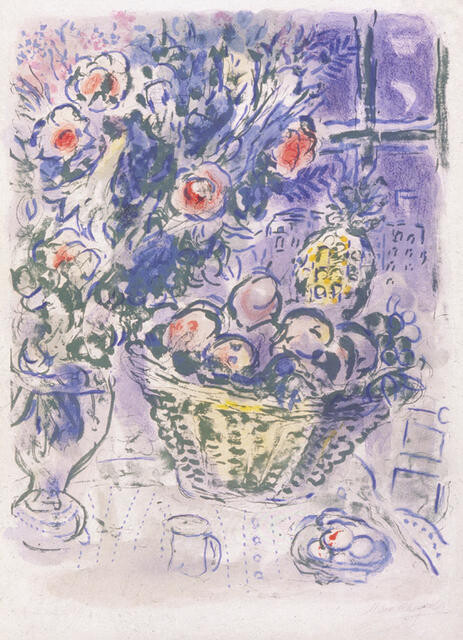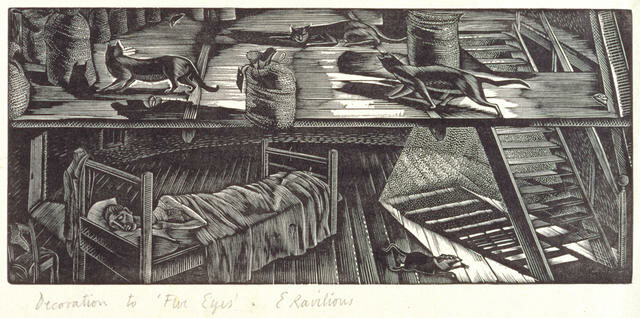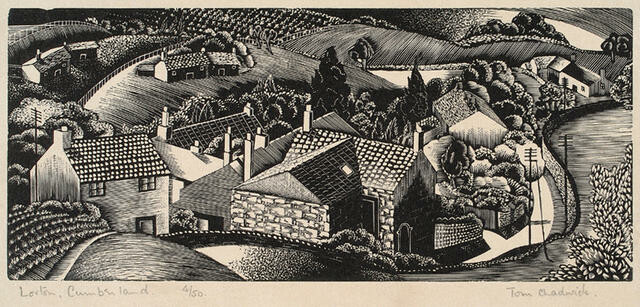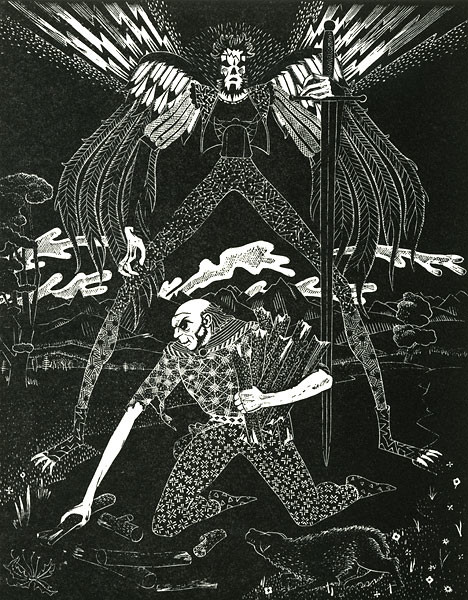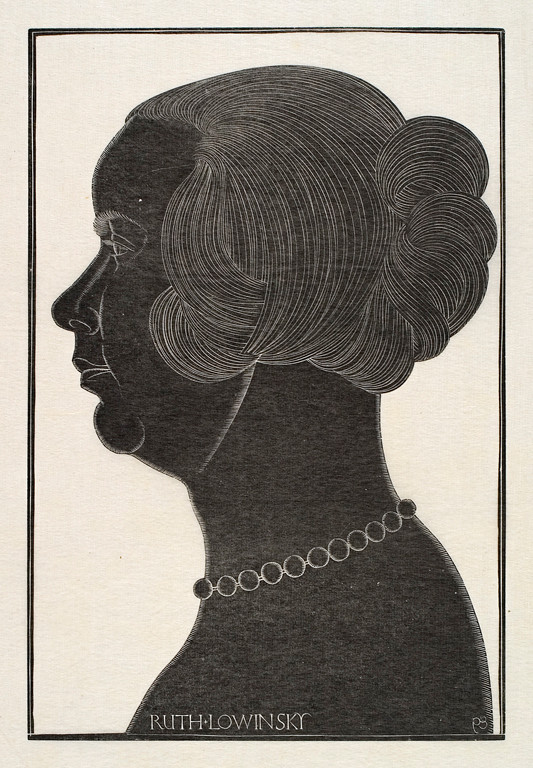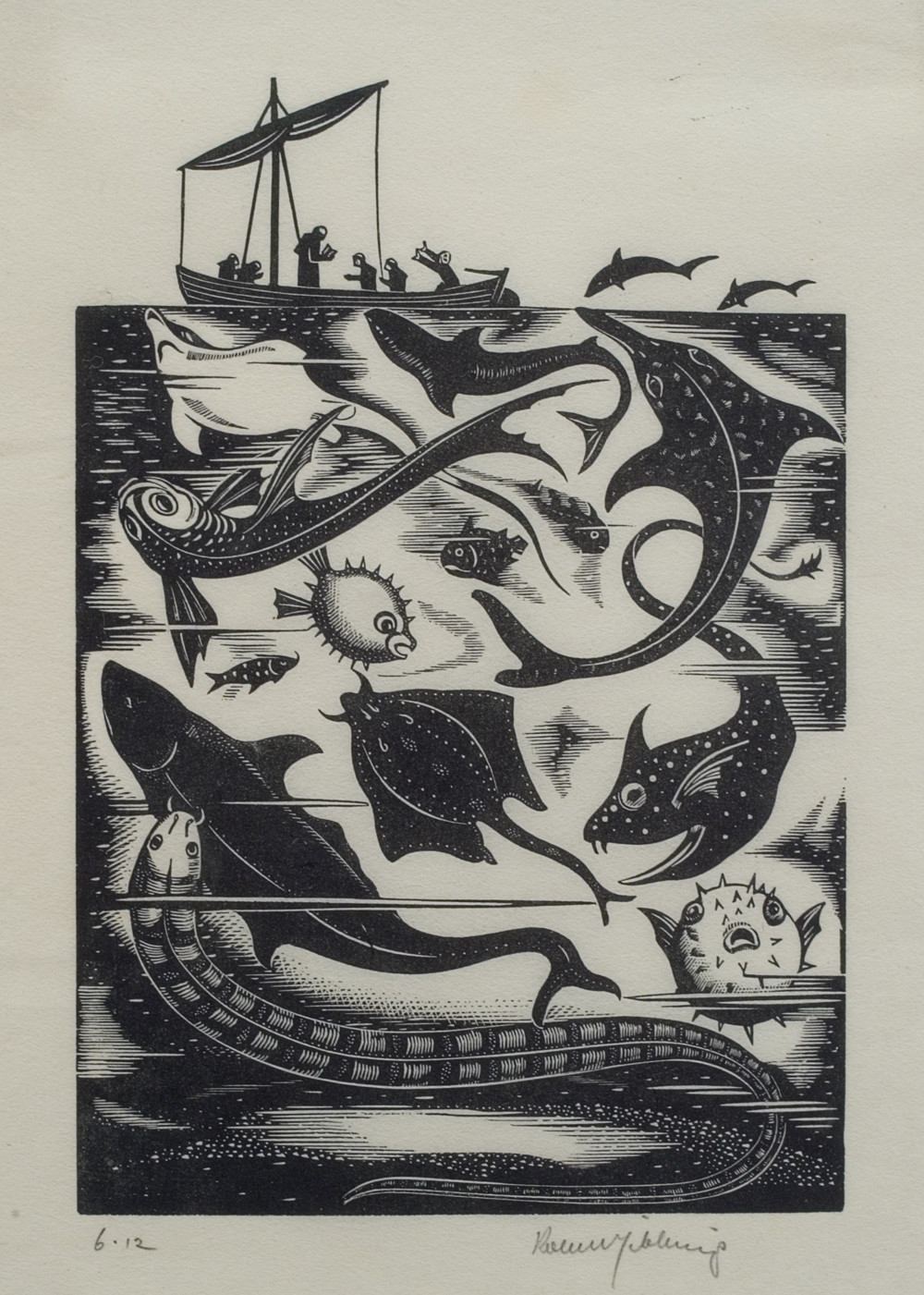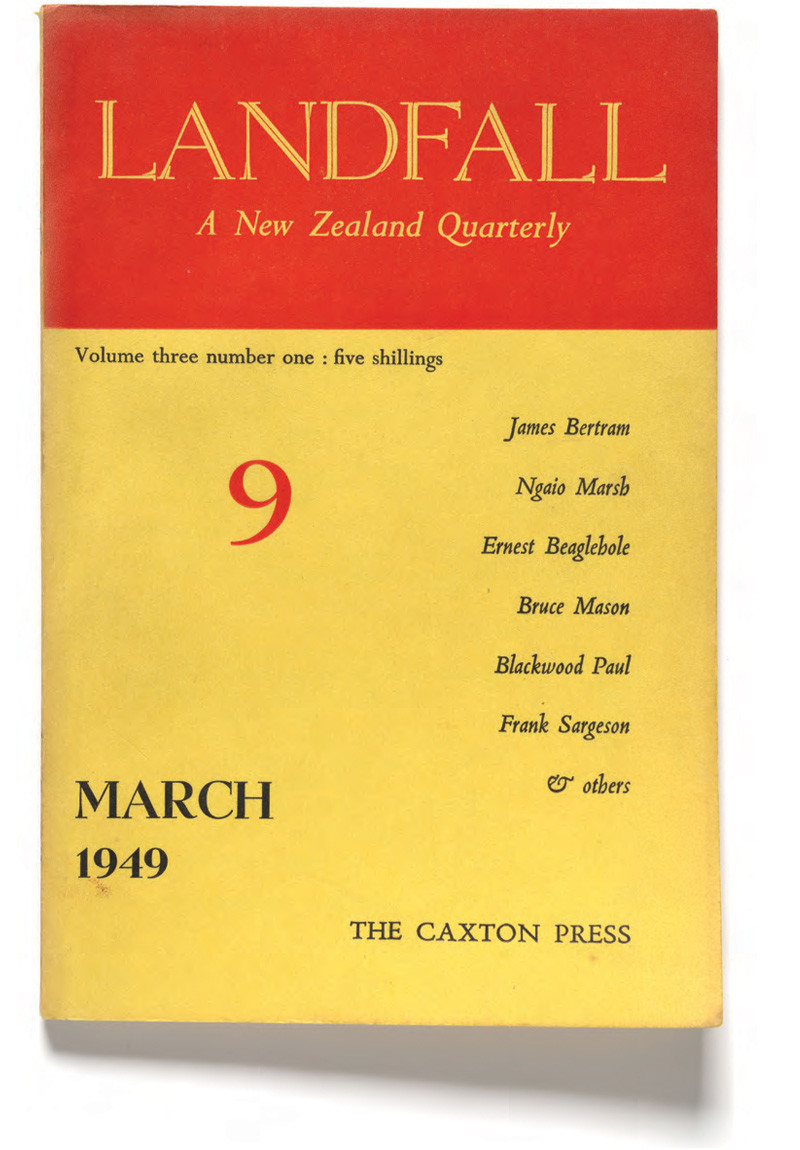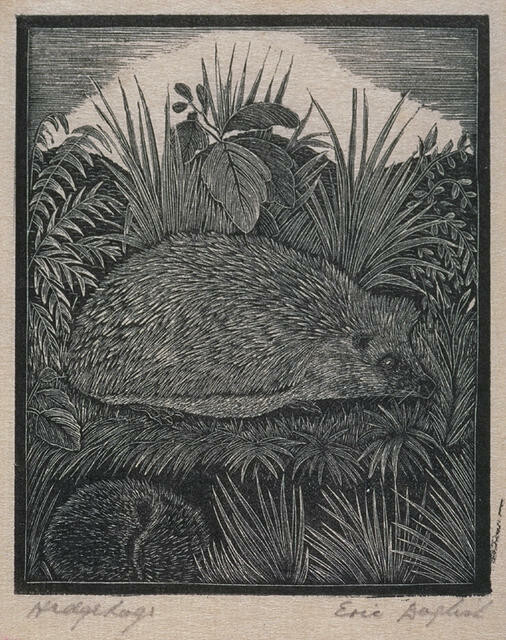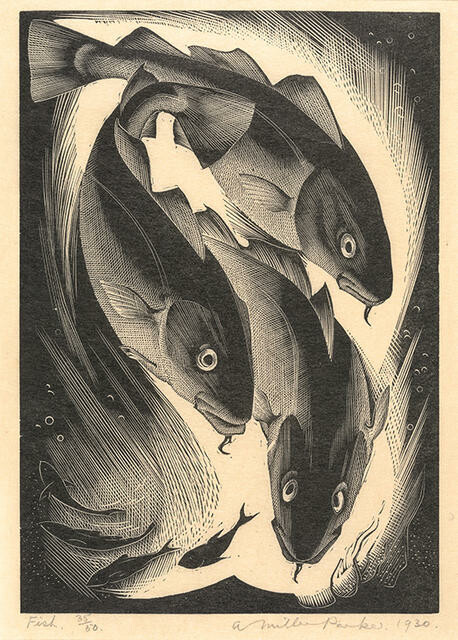B.
The Print Collection
Collection
If the question "what is the largest individual collection area numerically held by the Gallery?" was to be asked, the answer would have to be the Works on Paper collection, within which are 2145 original contemporary and historical prints, the earliest dating from the second half of the fifteenth century.
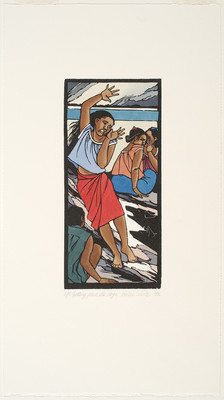
Robin White Getting past the dogs 1992. Woodcut. Collection of Christchurch Art Gallery Te Puna o Waiwhetū, presented to the gallery by the Civic Art Gallery Trust 1993. Reproduced with permission
When the Gallery opened in 1932, it had no print collection and it was not until 1936 that the foundations of one were laid as a result of a gift of 34 works made from the estate of Sir Joseph Kinsey. Kinsey had collected many hundred prints during his lifetime, mostly by British and European artists.
The prints gifted to the Gallery included etchings, drypoints and lithographs, primarily by popular British printmakers of the first two decades of last century. Among the artists were Malcolm Osborne, Graham Sutherland, Frank Short, Edmund Blampied, Seymour Haden, C. R. W. Nevinson, Norman Lindsay, Anders Zorn, Frank Brangwyn and C. H. Shannon. Images varied from prosaic landscapes by Frank Short to the slightly erotic work of the Swedish artist Anders Zorn and Australian Norman Lindsay. The Kinsey works were supported shortly afterwards by a gift of four prints from the Canterbury Society of Arts and included work by contemporary printmakers Job Nixon, Frank Brangwyn, Louis Rosenberg and G. Stetson Crawford. In 1943, a further eight prints were received by the Gallery as part of the Robert Bell Bequest, which included etchings by W. L.Wylie, Fred Richards, Mortimer Mempes, Joseph Pennell and Johnstone Baird.
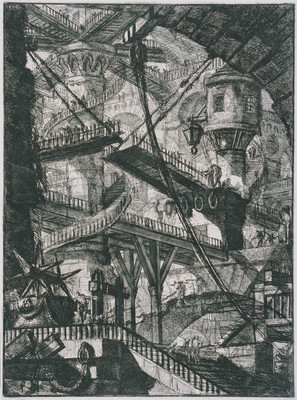
Giovanni Battista Piranesi Carceri Plate VII ‘An Immense Interior With Numerous Wooden Galleries And A Drawbridge In The Centre’ 1761. Etching. Collection of Christchurch Art Gallery Te Puna o Waiwhetū, purchased 1984
The growth of the collection was, however, slow and by 1950 it comprised just 48 prints mostly by British-born artists. All had been either gifted or bequeathed. During 1953 the first purchases of prints for the Collection were made by the Gallery when 2 lithographs by Juliet Peter and 3 Japanese wood block prints dating from the late eighteenth century and a lithograph by Henry Moore were acquired.
Earlier that year, the Christchurch - born owner of the Redfern Gallery in London, Rex Nan Kivell, gifted to the four main New Zealand galleries multiple prints by more than 100 contemporary British artists, among them Eileen Mayo, John Piper, Eric Ravilious, Eric Gill, John Nash, and Graham Sutherland.
The Gallery's selection, predominantly made up of woodcuts and lithographs, was addressed in error to the Director of Canterbury Museum, Dr Roger Duff. On being advised of
their arrival the then-honorary curator of the Gallery, William S. Baverstock was less than enthusiastic about receiving them into the collection and, after seeking the approval of the donor, decided to give 34 prints to the Canterbury Public Library. The disposal of the rest was undecided and was never resolved. For many years, it was assumed that this collection had been given away, but in October 1994 270 remaining prints were discovered in a drawer at Canterbury Museum and in 1997 the Nan Kivell gift was finally transferred to the Gallery and accessioned into the print collection. In 1954, the situation was reversed when on the death of May Moore, daughter of Sir Joseph Kinsey, several hundred prints bequeathed to Canterbury Museum were considered to be better placed in the Gallery. As a result more than 530 prints were accepted, and though they were of varied quality, with this gift the print collection size suddenly rose by more than 800%.
Whilst the Nan Kivell prints had been among the finest to be offered to the Gallery in the early 1950s, another unique opportunity arose at the end of that decade to acquire a selection of contemporary German prints from a 1959 touring exhibition and on this occasion it was taken up. Six lithographs by the artists Otto Dix, Rudolf Kugler, Harm Trier, Ewald Mataré, Rolf Müller-Landau and Johanna Schütz-Wolff were purchased. This purchase advanced the scope of international prints but until this point New Zealand printmaking had been largely ignored. This aspect of the collection was only advanced through a gift in 1961 made by the artist Francis A. Shurrock, who selected from his personal collection a number of prints by New Zealand artists, among them Alfred Cook, Alexander McLintock and Leo Bensemann. Through the remaining years of the 1960s, most prints were still acquired through donors rather than by purchase and the Gallery remained fortunate in this regard. In 1965, eight prints by Paul Sandby were received from the Heathcote Helmore Bequest. The next year Maureen Chute Raymond, an expatriate New Zealander, who had generously gifted many works to the Gallery over a number of years, had planned to give a still life flower painting by the prominent British artist Matthew Smith, but this was stolen from her home in London before she could do so. As a substitute work for the Collection, she purchased and presented the colour lithograph La Corbeille D'Ananas by Marc Chagall.
After a change of administration at the Gallery in 1969 and the introduction of the first collection policy, a new direction was set for growing all aspects of the existing print collection. Particular attention in the early 1970s was paid to improving holdings of contemporary New Zealand, international and historical master prints. A 1972 gift by artist and historian Gordon Brown of 41 historical and contemporary British and European prints was a considerable boost. Included were etchings, engravings, woodcuts and lithographs by artists from the seventeenth century onward.
Among some of the master prints purchased in the 1970s were several by William Hogarth, Rembrandt and a number from by nineteenth century French artists, including Edgar Degas, Camille Pissarro, J.B.C. Corot, and Paul Cezanne. Works by contemporary New Zealand printmakers such as Stanley Palmer, Robin White, Tom Field, Pat Hanly and Jeffrey Harris were also added to the collection at this time. Since 1979, major acquisitions of historical European and New Zealand prints as well as those by contemporary New Zealand and Australian artists has continued. Among the prints by historical European artists purchased are a number by Jacques Callot, Charles Meryon, Jean Millet, Giovanni Piranesi, Odilon Redon, Pablo Picasso, Francisco de Goya, James McNeill Whistler and Luigi Rossini. In recent decades, donors of historical prints have been rare but there have been exceptions such as Gordon Brown who was a generous donor in 1972 and in 1999 made a further important gift that included prints by Jacques Callot, James Runciman, and James McNeill Whistler.
New Zealand and Australian printmaking also remains an important focus and there has been a conscious improvement of representation of work by major printmakers such as Barry Cleavin, Robin White, Jeffrey Harris, Jason Greig, Denise Copland and John Drawbridge as well as painter/printmakers like Grahame Sydney, Ralph Hotere, Michel Tuffery and Fatu Feu'u.
There has also been an endeavour to acquire suites of prints where possible as well as individual prints. Of special significance in this regard was the purchase in 1990 of 40 prints titled Aus Australien. This comprises works by contemporary Australian artists such as Ken Unsworth, Mike Parr, Jenny Watson, John Nixon, Peter Tyndall and John Lethbridge. Other collaborative print workshop sets have been acquired and have included prints made by Tony Fomison, Ralph Hotere and Bill Culbert. Even though there is currently a stronger emphasis on advancing holdings of contemporary printmakers of Canterbury and elsewhere in New Zealand considerable growth in the area of historical New Zealand printmaking has taken place. In some cases, such as the recent acquisition of work by New Zealand artist A.J. Rae and expatriate Eleanor Hughes, substantial numbers of prints have been added.
As the Gallery moves forward towards a new chapter in its history, the commitment to continue developing the print collection seems assured.
Neil Roberts
